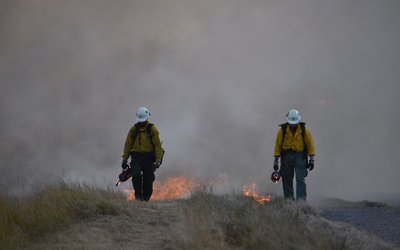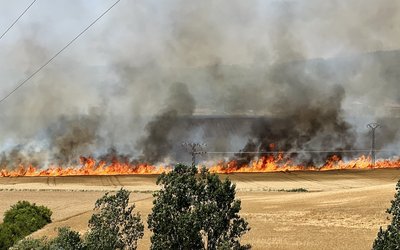Risk of unprecedented, extreme wildfires is spreading to the north of Europe
October 1, 2024

A sign indicating the highest risk of wildfires in Portugal (source: Contando Estrelas, www.flickr.com)
Wildfire danger increases
2003 was one of the most destructive wildfire years ever in Europe. Almost 650,000 hectares of forest in the European Union – over 25,000 fires stretching from the south to the north of Europe – went up in flames, according to estimates. The already extreme wildfire year of 2003 is surpassed by 2017, when almost one million hectares burned across the European Union. Wildfire danger in Europe is increasing. Future projections indicate that this trend will continue this century and that high-risk areas will expand across Europe, including central Europe and parts of northern Europe.
High-risk areas expanding northward
Historically, fire weather conditions in Europe are most severe in the Mediterranean, including Greece, Cyprus, Spain, Portugal and Turkey. Over the course of this century, similar fire weather conditions are projected for countries such as Kosovo, Bulgaria, Serbia, Moldova, Macedonia, and Malta. And wildfire danger will strongly increase in temperate mountainous regions as well, including Belgium, Germany, the Vosges, and the Massif Central. The only parts of Europe that will not experience a higher risk of wildfires are the core of the Alps and Scandinavian mountains.
According to the authors of this study, the wildfires in central Portugal in 2017 are an example of unpredictable fire weather due to unprecedented weather conditions. These fires burned 540,000 hectares, including complex mountainous terrain that was covered with accumulated fuel, and were driven by strong wind gusts and exceptionally high temperatures. The predictability of wildfires across Europe is changing. In southern Europe, wildfires are becoming more predictable: extreme fire conditions like in 2017 will occur on a regular basis over the course of this century. In central and northern Europe, wildfires are becoming less predictable: fire conditions may become unprecedented, even towards late summer.
By 2050, wildfire risk in the summer will likely increase across Europe regardless of the scenario of climate change. On the longer term, this increase is stronger for scenarios of more global warming, and the peak fire season will probably last longer.
Insufficiently prepared
These results underline that knowledge about fire weather regimes in the past may no longer fully apply to future trends, the authors conclude. For central Europe, in particular, weather conditions leading to large wildfires seem to become less predictable. The authors warn that countries in central and northern Europe may be insufficiently prepared for prolonged fire seasons since wildfire management has not been the priority of land use policies. Fuel-rich mountainous areas are especially at risk because sloped terrain hinders fire prevention measures and active suppression, and vegetation often intermingles with human settlements.
Source: Hetzer et al., 2024. Environmental Research Letters 19, 084017.








